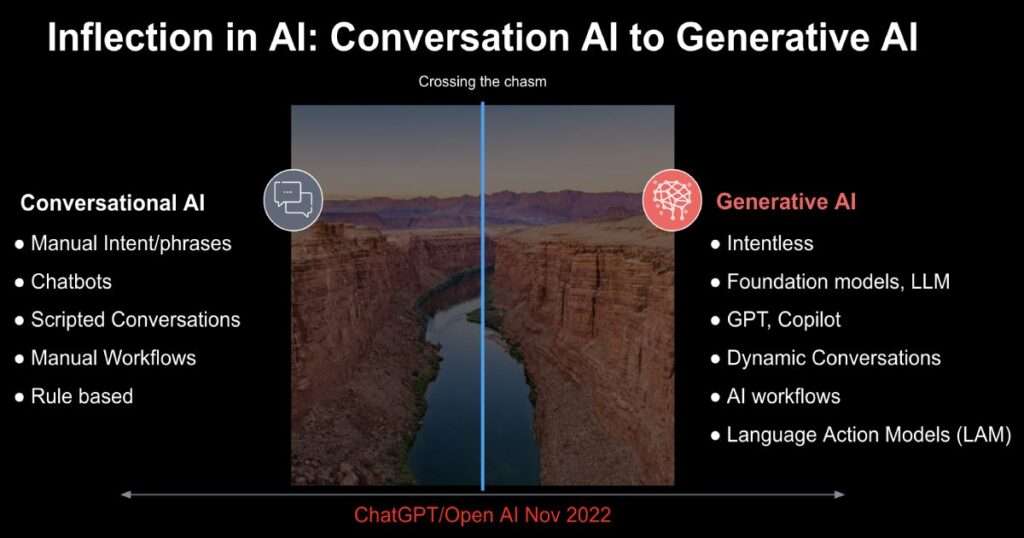Difference Between Generative AI and Conversational AI
Artificial intelligence (AI) is at the forefront of today’s technology, and as an IT leader, it is important to understand the differences between conversational AI and generative AI. Both types of AI leverage Natural Language Processing (NLP) and Large Language Models (LLMs), but they serve different purposes within your enterprise.
Conversational AI is focused on improving human-to-machine interactions with bots. Industry-specific dialogues are designed to make bot interactions more human-like, increasing the quality of user interactions. Generative AI creates original content, including blogs, stories, workflows, images, etc. to turn your ideas into reality.
In this article, we uncover the practical applications and transformative potential of these technologies, providing you with actionable insights to leverage them in your.
Fundamentals of Conversational AI and Generative AI
Looking at the key points of Conversational and Generative AI helps us understand them better. They both use NLP, but they have unique purposes and goals. This makes them different in how they work and what they do.
What is Conversational AI?
The conversational AI goal is to make conversation between humans and computers in human languages. It reads the meaning behind what we say and figures out things like dates or names. It can even pick up on how we’re feeling. You often find it in chatboxes, AI virtual assistants, and other places where human-like conversation is the main way to interact.
Understanding Generative AI
According to the glossary of AI terms, Generative AI takes creating things to a new level. With lots of training data, it can make something new, like a piece of writing or a drawing. This shows how different it is from other AIs, which might just answer questions or have basic chats. Generative AI is about making brand-new stuff.
Natural Language Processing in AI
Natural language processing is the power behind both Conversational and Generative AI. It helps them understand us and make fitting, engaging content. Whether it’s a simple chat or a complex drawing, NLP plays a big part in these artificial intelligence technologies.

Real-World Applications of Conversational AI and Generative AI
As AI continues to evolve, its practical applications are becoming increasingly evident across various industries. Here, we explore impactful real-world case studies that demonstrate the transformative power of Generative AI and Conversational AI:
Gen AI Use Cases
Generative AI is making significant strides across diverse sectors, including banking, insurance, and healthcare, demonstrating its versatility and impact as the core technology behind AI Copilot and AI Agents.
Banking: Generative AI in banking is revolutionizing the way banks engage with their customers. For example, one leading bank uses Gen AI to create personalized financial advice for its customers. By analyzing individual customer data, the AI system generates customized investment strategies and savings plans, enhancing customer satisfaction and engagement.
Insurance: Generative AI in insurance is employed to automate the processing of claims and underwriting. AI tools analyze historical data and generate risk profiles, significantly speeding up decision-making processes and reducing the likelihood of human error. This not only improves efficiency but also ensures more accurate risk assessment and policy pricing.
Healthcare: Generative AI in healthcare is transforming patient care by generating personalized treatment plans and predictive diagnostics. A healthcare provider uses AI to analyze medical histories and genetic information to tailor treatments that are specific to the genetic markers and health conditions of patients, leading to better health outcomes and more efficient use of medical resources.
Pharma and Drug Discovery: Nowadays, the important role of Generative AI in drug discovery and the pharmaceutical industry is deniable. By harnessing the power of advanced algorithms, researchers can now predict molecular behaviors and simulate drug interactions faster than ever before. This application accelerates the identification of viable drug candidates by efficiently generating and screening compounds, reducing the time and cost associated with traditional drug development processes.
For example, generative models can propose new molecular structures that target specific biological pathways with high precision, thereby enhancing the efficacy and safety of potential treatments.
Conversational AI Use Cases
Unlike Generative AI, which focuses on creating new and diverse outputs, Conversational AI is designed to enhance interactions between humans and machines, improving communication and automating customer service tasks. This technology powers solutions like Universal Bot and AI Voice Bot, enabling more natural and effective conversations, and providing timely assistance and support
A pronounced example of utilizing conversational AI is Google Assistant. But let’s see what Gen AI can do for the enterprise in the below examples:
Finance: Financial institutions utilize Conversational AI to offer personalized banking advice. For example, enterprise chatbots equipped with Conversational AI capabilities can answer user queries about account details, suggest financial products based on customer spending habits, and even assist in budgeting and financial planning. Leveraging conversational AI in finance not only improves customer engagement but also enhances the efficiency of financial advisors.
Insurance: Insurance companies employ Conversational AI models to streamline customer interactions and automate claims processing. A leading insurer has integrated a Conversational AI system into its AI customer service operations to handle claims registrations, policy inquiries, and insurance renewals over chat and voice interfaces. Conversational AI in insurance not only speeds up the processing of claims by guiding customers through the necessary steps but also provides real-time answers to policy-related questions, thereby enhancing customer satisfaction and operational efficiency.
Healthcare: Conversational AI in healthcare revolutionizes patient interaction and support in healthcare settings. Hospitals and clinics use AI-driven virtual assistants to assist patients with appointment scheduling, medication reminders, and providing information about procedures and care. For instance, a virtual health assistant can engage with patients to manage their chronic conditions by offering tailored advice and reminders for medication, significantly improving adherence to treatment protocols and patient outcomes. Additionally, these virtual assistants can handle routine inquiries, freeing up medical staff to focus on more complex patient care tasks.

Conversational AI vs Generative AI: Distinguishing Features
It’s key to know how conversational and generative AI differ to use them effectively. Conversational AI works best for on-the-spot talks, benefiting customer service and learning apps. In contrast, generative AI shines in creating new content, boosting innovation in media, design, and software.
Conversational AI improves direct talks for better user experiences. Meanwhile, generative AI focuses on creating and adding creativity to digital spaces. The technology each uses affects how they shape the world.
| Feature | Conversational AI | Generative AI |
| Core Function | Facilitates interactive communication using natural language processing | Creates new and unique content based on learned data patterns |
| Primary Applications | Customer support, virtual assistants, educational bots | Content generation, design and media creation, data analysis simulations |
| Technology Use | Relies on NLP and machine learning for understanding and responding | Leverages deep learning networks to generate text and images |
| Example Tools | Chatbots, Siri, Amazon Alexa | ChatGPT, DALL-E, Midjourney |
| Business Impact | Enhances user engagement and automates customer interactions | Drives innovation by automating creative processes |
Training Techniques for Conversational and Generative AI Models
AI technology is advancing quickly, leading to new training needs for large language models (LLMs). These include both generative and conversational AI systems. They use big datasets to get better at what they do. Those in the AI field need to grasp these fundamental training methods as technology progresses.
Training Data for Generative AI
Generative AI is taught using large amounts of training data from the foundation models, domain-specific LLMs, or small language models (SLMs). This data comes in many forms, from text to images. By deep learning techniques through these diverse datasets, generative AI can make new and contextually fitting creations. Managers must adjust these models using specific generative AI training methods. This helps AI make content that feels real to people.
Custom Language Models for Conversational AI
Conversational AI aims to talk like a person, knowing what to say and when. It learns using models based on real chats, often geared to certain fields. These models go beyond words to understand tones, meanings, and feelings. This makes training conversational AI key to making AI systems that are both smart and caring.
Although both types of AI use machine learning, their uses and results are different. For conversations, custom models are at the heart of improvement. They help AI talk in human language in real time. On the other hand, generative AI needs large and varied datasets. These enable it to create content in ways we’ve never thought of before. So, the field of generative AI is always growing and changing.
Purposes and Value of Conversational AI vs Generative AI
AI technologies like Generative AI and Conversational AI are pivotal in driving efficiency, innovation, and competitive advantage across industries by automating tasks and enabling advanced decision-making and personalized interactions.
Strategic Value of Gen AI
Generative AI is crucial for creating new content from existing data, streamlining product development, and enhancing creativity across sectors like marketing and design. It reduces time-to-market and lowers costs by automating the generation of visual and textual content, aiding in rapid innovation and tailored product offerings.
Strategic Value of Conversational AI
Conversational AI enhances customer engagement and automates communication processes, providing 24/7 support and handling large volumes of inquiries without additional human resources. It improves customer satisfaction and operational efficiency, especially in regulated industries like banking and healthcare, by ensuring compliance and delivering personalized advice efficiently.
Ethical Considerations in AI: Responsible Usage and Compliance
Building and using conversational and gen AI includes deep ethical issues. These affect how we use them in our world. When looking at conversational vs generative AI, we see each has its unique problems. Both need careful thought in their design and use. Conversational AI, for instance, needs to be big on privacy and data safety. It has to protect data from getting into the wrong hands, which could hurt people and businesses.
Gen AI, on the flip side, must deal with making sure its content is not false or misleading. This includes things like deepfakes. It’s not just about what this false content can do to people, but also how it can shake up society. Making sure Gen AI sticks to the truth in what it creates is a hot topic in the ethics world.
Keeping up with ethical standards and teaching people about conversational AI ethics is super important. We need rules that follow the law and can change as AI gets better or different. This helps keep the relationship between AI and people healthy and helps AI do good things in our world.
| AI Type | Key Ethical Considerations | Examples of Potential Ethical Breaches |
|---|---|---|
| Conversational AI | Data security, Privacy protection, Compliance with regulations | Unauthorized data access, misuse of personal information |
| Generative AI | Accuracy of content, Prevention of misleading information | Creation of deceptive media (deepfakes) |
The Future of Conversational AI and Generative AI
In today’s fast-moving environment, organizations are leveraging transformative AI to drive innovation and create a smarter business ecosystem. Predictive AI shines a light on market trends and customer behavior, enabling businesses to act proactively. When combined with conversational AI, predictive AI illuminates customer journeys and empowers agents to provide highly personalized service.
Agentic AI takes conversational AI and generative AI to the next level by adding autonomous decision-making and real-time adaptability. Generative AI is then able to create context-aware content that is highly relevant and engaging, dramatically improving customer experiences and business operations.
Predictive, generative, and conversational AI are not three separate trends; they are intertwined forces of innovation that are transforming business, boosting productivity, and fostering growth. As these technologies evolve, it is equally important to focus on their ethical and human-centered applications to ensure positive business results while creating meaningful customer experiences.

Conclusion
Exploring Conversational and Generative AI reveals their pivotal roles in advancing technology. Conversational AI enhances customer interactions by understanding and processing language nuances, improving service efficiency in real-time communication. In contrast, Generative AI fosters innovation by creating original content, revolutionizing fields like marketing and design with autonomous creativity.
Both AI types offer strategic benefits: Conversational AI boosts user engagement and operational efficiency while getting started with generative AI reduces costs and speeds development cycles. Their integration promises sophisticated tools capable of advanced understanding and innovation, essential for the future of business and technology.
As these technologies evolve, ethical considerations, including privacy and accuracy, remain crucial. Navigating these concerns responsibly ensures the beneficial use of AI, highlighting the importance of strategic application in an increasingly AI-integrated world.
Learn more about Aisera’s Conversational AI platform and the AI products powered by Aisera’s Gen AI. You can experience the capabilities of Gen AI by booking a custom AI demo for your enterprise today!

